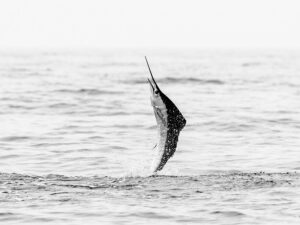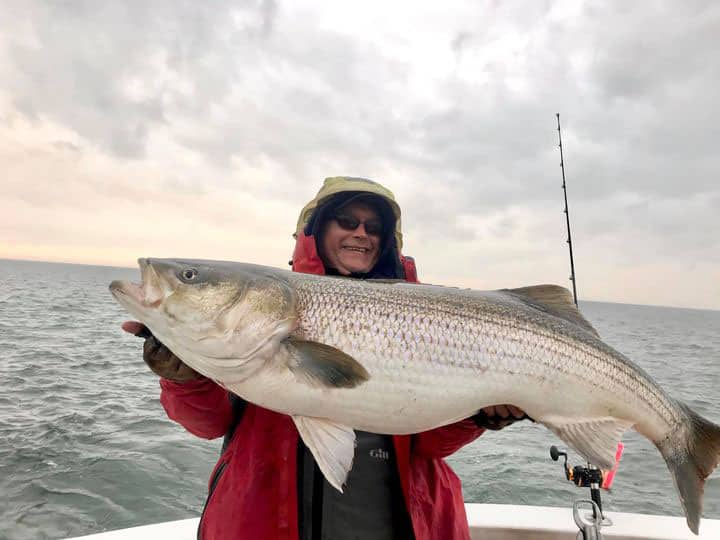
It’s the middle of February, four hours into a battle with a monster bluefin tuna, and the only thing between me and the wind-driven sea spray is my rain gear. Six months later, a summer thunderstorm blows up and my rain gear protects me from driving wind and pelting rain. Rain gear used to leave us hot and wet or cold and wet, but the latest technologies and designs bring comfort in inclement weather.
The Old Slicks
Polyurethane is an old technology finding new life. Polymer-coated cotton isn’t breathable or light, but it is absolutely water-, wind- and stain-proof. It’s also durable and inexpensive. That’s why polyurethane (PU) remains the best choice for the worst fishing conditions.
Grundéns is almost synonymous with PU-coated rain gear. I have a set of Grundéns hanging in my garage. The Herkules bibs and Neptune jacket are classics, as functional today as they ever were. Jim Kershaw, Grundéns’ director of product design, says, “If you’re spending the day running bait and are going to be around blood, oils and grime, there is no better solution to stay dry and clean than PU-coated rain gear.”
To improve comfort, Grundéns’ PU-coated polyester is lighter with more stretch than cotton. Kershaw says, “While we are still offering heavier PVC for commercial applications, coated fabrics have evolved to be lighter weight and offer unparalleled stretch, making them the perfect solution for any angler looking to stay dry and clean.”
For the messy work of rigging live baits and gaffing kings or cutting chum and bailing dolphin, I can just rinse off the mess with PVC or PU gear. There’s still nothing better for the toughest fishing conditions.
Space to Breathe
Breathable fabrics were invented in the 1970s, and anglers were some of the first to benefit. The technology combines moisture-wicking inner fabric with a perforated outer layer. Microscopic holes in the outer layer are large enough to allow water vapor to exit but too small to permit water to enter. Today’s breathable fabrics are even more waterproof, breathable and durable.
No one knows rain gear better than professional tournament anglers. To design their new Pro Series rain kit, Huk went to their pro staff for testing and development. Huk’s vice president of marketing Scott Smith says, “Pro anglers fish 300 days of the year. It’s always raining and nasty.”
Waterproof fabric is rated from 5k to over 50k, indicating the amount of water pressure the fabric can withstand without leaking. Breathability is measured the same way, with the lower number indicating better vapor evaporation. “The challenge is increasing breathability and water resistance without increasing weight,” Smith says. The new Pro Series rain suit features 30k waterproof and 15k breathability ratings, and it’s surprisingly light. Weight savings doesn’t come at a sacrifice of durability, either. “Our pro anglers complained that they go through two or three rain suits each year,” Smith says. The Pro Series kit features heavier fabric in high-wear areas.
Columbia PFG takes a different approach. OutDry Extreme flips the script with the waterproof membrane on the outside and a soft material on the inside. Scott Greenwood, senior director of design at Columbia explains, “OutDry doesn’t need spray-on water repellent.” To reduce weight and bulk without sacrificing performance, Columbia developed a durable, breathable membrane that stands on its own without protective layers or added waterproofing.
The key to staying dry and comfortable is choosing the best material to protect from the elements. Design features work with the fabric to finish the job.
Read Next: Really? You’re Gonna Cancel at the Last Minute Because of a Little Rain?

Fit and Design
The true test of rain gear comes on a speeding flats boat in a driving rain. With the wind blowing water in every direction, a rain suit needs to shed water and permit movement.
The hood is the crowning achievement on any rain jacket. The hood must keep rain and wind out while allowing the angler a full field of vision and movement. Designers obsess over hood shape and adjustability. Greenwood at Columbia says, “If the hood is not adjustable, keep looking.” The new Force XII rain suit has a bonded brim and adjustable elastic crown to keep the hood secure.
Huk’s Pro Series uses an integrated clip to attach the hood brim to the angler’s hat brim along with three cinch points and venting to secure the hood. “I was tired of holding my hood in place while we were running,” Smith explains.
Pockets are also important. Greenwood says the Force XII doesn’t limit function when taking off the jacket. “We put pockets in the bibs, too,” he says. The pockets are sealed with waterproof zipper and a storm flap. Huk’s Pro Series has more pockets including pouches on the bib legs with an opening to hold a pair of pliers. I like the stretchy neoprene pockets inside the front of the bibs to hold my sunglasses.
Anglers also expect jacket sleeves with sealed cuffs. Columbia’s Force XII rain jackets use a neoprene cuff that hugs the wrist to seal out water. The Pro Series jacket from Huk uses an adjustable neoprene cuff and outer cuff to allow the angler to dip his arm in the water without getting wet.
Articulated hoods, sealed sleeves, waterproof zippers and adaptable closures improve comfort and versatility.
Choosing Rain Gear
“I don’t just wear my rain wear when it rains,” says Smith, pointing out that rain gear also protects from cold and wind. “I’m really looking for something versatile for any conditions.”
One of the objectives for the Pro Series rain kit was balancing weight between cold and warm weather. “The inner layer is soft to wear with short sleeves and shorts or I can add layers of clothes to stay warm in winter,” he explains.
Hands down, polyurethane rain gear is 100 percent waterproof and windproof and the best choice for the worst weather. Kershaw at Grundéns points out: “PU is the choice of commercial fishermen because it is durable and inexpensive with reliable performance.”
Under normal circumstances, recreational anglers don’t have to dress like Deadliest Catch to stay warm and dry. A lighter-weight PU rain suit protects against the elements without breaking the bank.
Anglers who don’t let the weather rain on their parade upgrade to a breathable, waterproof system. Investing in a high-quality rain suit makes miserable weather more enjoyable. A lightweight set of rain pants and jacket is enough for summer squalls. For winter weather, a heavier rain kit traps warmth and blocks stinging wind.
Care and Maintenance
Buying a quality set of rain gear is a long-term relationship. Polyurethane rain gear is easy to maintain. Kershaw says, “Just rinse off salt, blood, oil or acids and hang to dry.”
Breathable rain gear requires maintenance. Smith at Huk describes the outer membrane as a forest of microscopic trees. “Any dirt or oil knocks down the trees,” he says. To keep the membrane functional, Smith recommends regular washing and re-applying waterproof coating. “Washing is an essential part of owning a breathable rain suit,” he says.
Kershaw adds that the ban on PFAS chemicals complicates care and maintenance. “Breathable fabrics use PFAS to repel water,” he says. PFAS are labeled forever chemicals and were recently banned by the government. “Grundéns is committed to using alternatives to replace the PFAS chemicals,” he says.
Greenwood at Columbia points out that OutDry Extreme doesn’t use PFAS to repel water: “It’s not affected by the new laws because of the way it is constructed.” He says the recent laws make OutDry Extreme more relevant. The ban on forever chemicals is sending rain-gear designers back to the drawing board to come up with new materials that responsibly protect anglers from the conditions.









